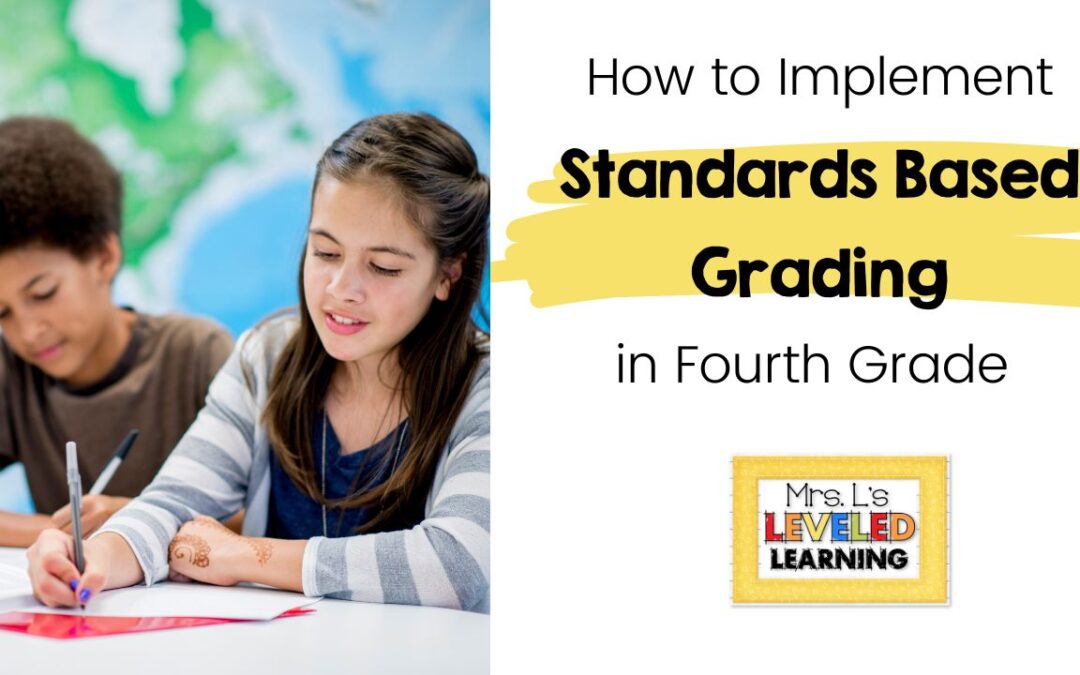Standards-based grading (SBG) and differentiation are transformative approaches in elementary education! They focus on fostering a growth mindset and enhancing cognitive skills by gradually moving students from background knowledge to mastery. First, instruction and assessment are aligned with clearly defined learning standards. This allows you, the classroom teacher, to more effectively plan for the diverse needs of your specific population. The top three research-based benefits of implementing a standards-based approach are: having clear learning targets to enhance students’ understanding, providing assessments that more accurately reflect real student progress, and facilitating individualized learning profiles for differentiation. Here’s three practical ways to implement standards-based grading in your classroom:

1. Develop Clear Standards Based Rubrics
Create detailed rubrics that break down each standard into specific, measurable criteria. I like to use 3 or 4 levels of proficiency. These are sometimes called Proficiency Scales. This helps both teachers and students understand how to make small steps towards mastery. For example, a rubric for a math standard might include criteria for identifying vocabulary, modeling concepts, performing calculations, and applying knowledge to solve problems.
Implementation Tip: Share these rubrics with students at the beginning of a unit so they know exactly what is expected. (I like to post them on a wall or board during class!) Use the rubrics consistently to provide feedback and guide students towards improvement.

2. Use Standards Based Assessments to Guide Instruction
Incorporate frequent formative assessments that align with the standards. This helps you and your students monitor progress and adjust instruction. These can include quizzes, exit tickets, and observational checklists. Formative assessments provide immediate feedback, allowing you to adjust your teaching strategies. I like to give the same leveled tests as a pre- and post-assessment so students see their progress on the same page!
Implementation Tip: Regularly analyze the results of formative assessments to identify patterns and adjust grouping strategies. This ensures that instruction is continuously tailored to support student growth. (If you use the pre- and post-method too, be sure to share student results with them both times! I like to share pre-test results in small instructional groups. Students see their final post-test results at the end of our unit.) Results can be shared in traditional grades (A-B-C-D), percentages, or mastery levels (1-2-3-4).

3. Create Flexible Grouping Strategies
Organize students into flexible groups based on their mastery of specific standards. These groups can change as students progress, ensuring that each student receives the appropriate level of challenge and support. For example, in a reading class, you might have groups focused on different skills such as…
- phonics (leave 1)
- fluency (level 2)
- comprehension (level 3)
In a math class, you might have one group…
- working with manipulatives (level 1)
- drawing models (level 2)
- solving higher-level word problems (level 3)
Implementation Tip: Use data from formative assessments and observations to plan differentiation for your student groups. This dynamic approach to grouping helps to keep instruction relevant and engaging. I like to give students a chance to prove themselves for each unit of study (every 4-6 weeks). This helps them to feel like they’re not stuck in one group all the time. It reinforces the idea that we’re all strong or weak in different things, and can always work our way up to the next level!
Keep Your Differentiation Elementary!
Adopting a standards-based approach to grading and differentiation in the elementary classroom offers significant benefits, including clearer learning targets, fairer assessments, and personalized learning experiences. By developing clear rubrics, using formative assessments, and creating flexible grouping strategies, teachers can effectively implement standards-based grading to foster a growth mindset. Embracing these strategies can transform the learning experience, ensuring that all students have the opportunity to develop cognitive skills from one manageable level to the next!
To find Fourth Grade Standards-Based resources that are already organized for differentiation, follow the link below:
4th Grade Standards Based BUNDLE for Differentiation in Math
4th Grade Standards Based BUNDLE for Differentiation in Reading
“This resource has been very helpful with the detailed rubrics and Google forms for each standard (ELA). This resource saved me so much work!” – Katrina T.
“I absolutely love this resource. I use the pdf version, which requires a bit of printing, but it helps me keep a close eye on who is actually writing good responses, and then I use their responses for my classroom “work wall”. My principal was excited to see my student’s responses and my notes on the pages about what was good and what student’s needed to work on. I have gotten to the point where I know how many level 2’s, vs. level 3’s and 4’s I need to print. I am also letting lower students start on level 2 and then rise them up! Thank you for creating this resource, especially with helping students with written responses to each standard!” – Nancy D.
“This resource has helped my online students understand their learning expectations. The have starting using the proficiency scales with pictures and they are recognizing what they need to do to the scale progress upward on the scale. This was a huge time saver for me and helped my students better understand what a power standard is.” – Suzanne O.




